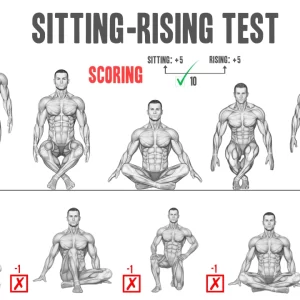Contents
Strength training is built on a simple but powerful principle: your body adapts to the challenges you place upon it. Lift the same weight for the same reps every week, and eventually, your muscles will stop responding. Add too much too soon, and your joints, tendons, or nervous system may give out before your muscles can grow stronger.
This balancing act — knowing when to increase the weight and by how much — separates long-term progress from stagnation or injury. Let’s break down how to recognize the right time to increase your weights, how to do it safely, and the exact systems you can use to make consistent, measurable gains in strength and muscle size.
The Foundation: Progressive Overload
At the heart of weight training lies progressive overload, a concept first studied in depth by physiologist Thomas Delorme in the 1940s. Simply put, it means gradually increasing the demands placed on the body to stimulate continuous adaptation.
Progressive overload can be applied in several ways:
- Increasing the weight lifted
- Increasing the repetitions performed with the same weight
- Adding more sets
- Reducing rest time between sets
- Improving tempo or range of motion
While all of these methods work, most lifters naturally think first about adding more weight. However, progression should be systematic — not reckless.
Signs You’re Ready to Increase the Weight
Not every workout demands heavier weight. Here are the key signs that signal readiness for progression:
1. Your Reps Feel Too Easy
If your program prescribes 8–10 reps, but you find yourself comfortably hitting 12–13 with no struggle, your muscles have likely adapted, and the load is no longer sufficient.
2. You Maintain Perfect Form
Progress should not come at the expense of technique. If you can move through all prescribed reps with controlled, strict form, without jerking, swinging, or compensating with other muscles, the current weight is likely too light.
3. You Finish Without Fatigue
Resistance training should leave you feeling challenged. If you complete every set and feel like you could repeat the entire workout without much effort, it’s time to progress.
4. Consistency Over Time
If you’ve used the same weight for several weeks in a row without pushing yourself closer to your rep limit, your body has likely plateaued.
5. The “2-for-2 Rule”
A reliable guideline is the 2-for-2 rule:
- If you can perform two additional reps beyond your goal,
- In your final set,
- For two consecutive workouts,
Then you’re ready to increase the weight.
How Much Weight Should You Add?
Progression is highly individual, but here are evidence-based recommendations:
For Upper Body Exercises
Increase by 2–5% of the load. Example: if you bench press 100 lbs, move up by 2–5 lbs.
For Lower Body Exercises
Increase by 5–10% of the load. Example: if you squat 200 lbs, move up by 10–20 lbs.
For Bodyweight Exercises
Increase difficulty with:
- Weighted vests or belts
- Resistance bands
- Tempo adjustments (slower eccentrics, pauses)
- More challenging variations (e.g., standard push-up → decline push-up → single-arm push-up)
The smaller the jump, the better. Strength is built through consistent, manageable progressions, not sudden leaps.
Progression Strategies: Different Models
There are several ways to structure how and when to add weight. Choosing the right one depends on your goals and training experience.
1. Linear Progression
- Best for beginners.
- Add small increments each workout until progress stalls.
- Example: Increase squat by 5 lbs every session.
2. Double Progression
- Best for hypertrophy (muscle growth).
- Increase reps first, then add weight.
- Example: Work in an 8–10 rep range. When you hit 10 reps comfortably, increase the weight and return to 8 reps.
3. Step Loading
- Best for intermediate to advanced lifters.
- Train at a given weight for several weeks, then jump to a higher weight after a “deload” or rest phase.
- Example: 4 weeks at 150 lbs, then move to 160 lbs after a rest week.
4. Autoregulation (RPE or RIR)
- Best for experienced lifters or athletes.
- Use subjective effort (Rate of Perceived Exertion) or “Reps in Reserve” to guide load increases.
- Example: If a set feels like RPE 6 (4 reps left in the tank), you can safely increase weight.
Common Mistakes to Avoid
Even with good intentions, many lifters fall into traps when adding weight:
- Jumping Too Fast
Adding 20–30 lbs at once, especially on upper body lifts, often leads to injury. - Ignoring Recovery
Progress only happens if your body has time to rebuild. Without sleep, proper nutrition, and rest, heavier loads will backfire. - Sacrificing Form for Numbers
A heavier squat with shallow depth or a rounded back does more harm than good. Technique should always come first. - Comparing With Others
Progress is individual. Chasing someone else’s numbers often leads to ego lifting.
Practical Examples
- Beginner Example (Bench Press):
- Week 1: 3×8 at 65 lbs
- Week 2: 3×9 at 65 lbs
- Week 3: 3×10 at 65 lbs → increase to 70 lbs
- Week 4: 3×8 at 70 lbs
- Intermediate Example (Squat):
- Train at 185 lbs for 4 weeks, increasing reps within the 6–8 range.
- When 8 reps feel easy, move to 195 lbs.
- Advanced Example (Deadlift):
- Use RPE system. Pull 365 lbs at RPE 7 (3 reps left in the tank).
- Increase to 375 lbs the next week, staying within the target RPE.
How Often Should You Increase the Weight?
The frequency depends on training experience:
- Beginners: Every 1–2 weeks (linear progressions work best).
- Intermediates: Every 3–4 weeks (progress slows as strength develops).
- Advanced lifters: Every 6–8 weeks or longer (small gains take more time).
Remember: more experienced lifters require more subtle and strategic increases.
The Role of Recovery in Progression
Increasing the weight is only one side of the equation. Recovery determines whether your body can handle it. Prioritize:
- Sleep (7–9 hours per night)
- Nutrition (adequate protein and total calories)
- Deload Weeks (planned reduction in intensity every 4–8 weeks)
Without recovery, even small weight increases can lead to fatigue, joint pain, or regression.
Final Takeaway
Knowing when to increase the weight — and by how much — is the key to long-term strength and muscle development. Use clear signals (perfect form, surplus reps, lack of challenge), progress gradually (2–5% upper body, 5–10% lower body), and choose a structured progression model that fits your training experience.
Remember, consistency and patience are more important than speed. The best athletes in the world got stronger through years of small, smart progressions — and so will you.
References
- American College of Sports Medicine. (2009). Progression Models in Resistance Training for Healthy Adults. Medicine & Science in Sports & Exercise, 41(3), 687–708.
- Baechle, T. R., & Earle, R. W. (Eds.). (2008). Essentials of Strength Training and Conditioning. NSCA.
- Kraemer, W. J., & Ratamess, N. A. (2004). Fundamentals of Resistance Training: Progression and Exercise Prescription. Medicine & Science in Sports & Exercise, 36(4), 674–688.
- Schoenfeld, B. J. (2010). The Mechanisms of Muscle Hypertrophy and Their Application to Resistance Training. Journal of Strength and Conditioning Research, 24(10), 2857–2872.
- Helms, E. R., Zourdos, M. C., & Storey, A. (2016). Practical Applications of RPE in Resistance Training. Strength and Conditioning Journal, 38(4), 42–49.



